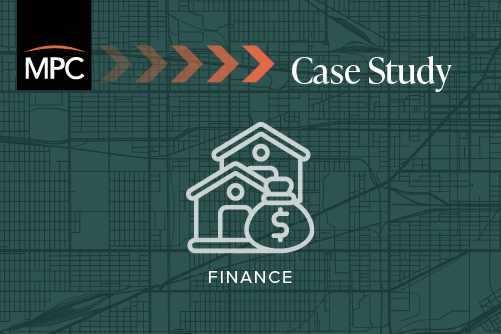South Suburban Land Bank and Development Authority
South Chicago suburbs
Finance

Background
Many of Chicago’s south suburbs have been particularly hard hit by the recent foreclosure crisis. The Southland has been a major target for subprime lending; coupled with a continuous cycle of disinvestment, this part of the region has found it difficult to stabilize neighborhoods and get back on a path toward growth. The South Suburban Land Bank and Development Authority (SSLBDA) was one of the housing tools developed to alleviate the effects of widespread foreclosure, vacancy and blight and spark economic revitalization.
The SSLBDA was formed in 2012 through an intergovernmental agreement passed by the Village of Park Forest, City of Oak Forest and City of Blue Island. This regional economic development initiative—seeded by a U.S. Dept. of Housing and Urban Development (HUD) Sustainable Communities Grant—was established to provide additional capacity to municipalities that have limited staff and financial resources. The SSLBDA provides a means for communities to hold, manage and develop vacant and foreclosed properties so that they can be put back into good use. The land bank currently has 12 member communities and operates in Cook and Will counties.
How it works
The SSLBDA is currently staffed by one executive director, who works closely with other regional partners to maximize the land bank’s impact in south suburban communities. Municipalities seeking SSLBDA membership must adopt an intergovernmental agreement; then they may appoint a board member to the SSLBDA. The SSLBDA has been intentional about closely aligning with municipal needs in the face of local and regional challenges. The land bank works with cities to determine high-priority properties for acquisition and redevelopment, and targets projects that make economic sense for both the land bank and the municipality. The land bank focuses most of its efforts on properties that have the highest impact, including properties within identified redevelopment areas, near other community investments, near schools or other neighborhood anchors and/or near transit. Properties that are acquired and redeveloped are ideally sold to owner occupants, per municipal preferences.
The SSLBDA is afforded a large scope of powers by way of intergovernmental agreements signed by participating municipalities. These intergovernmental agreements allow the land bank to hold properties tax-exempt, clear taxes and adopt home rule powers, which give it the authority to license, tax and incur debt. The lank bank does not have any restrictions on who they can buy or acquire properties from as long as it is approved by their board of directors and executive committee. The money brought in from the sale of properties generally goes back to the land bank, though there may be different financial arrangements between the land bank and an individual municipality. Sale prices are set by the lank bank, which often works with municipalities, appraisers and brokers to determine the market value of homes to be sold. The SSLBDA is looking to move toward a self-sustaining model as it continues to build its membership base and expand its capacity to acquire properties and redevelop homes and facilitate economic growth across south Cook and Will counties.
Contact
South Suburban Land Bank and Development Authority
708-381-0871, www.sslbda.org
-
Goal
To foster sustainable, healthy and stable communities through the redevelopment of troubled properties
-
Target
Troubled residential and commercial properties
-
Financing
Attorney General National Foreclosure Settlement Award: $1.5 million
Ill. Housing Development Authority (IHDA) Abandoned Property Program: $550,000
-
Success
- The land bank has been able to raise over $2.25 million since it formed in 2012.
- The land bank has acquired eight properties to date, helping to promote neighborhood stabilization in hard-hit communities.
- There are 12 participating municipalities in the land bank, with additional communities across the region expressing an interest in joining.
-
Lessons learned
- Obtaining a municipality’s input and generating buy-in are important steps to take when identifying projects with strong potential to stabilize neighborhoods.